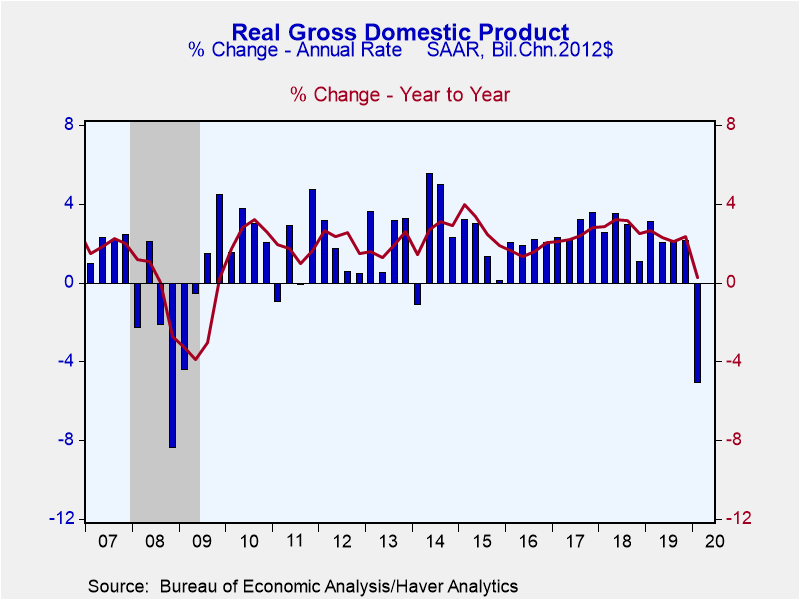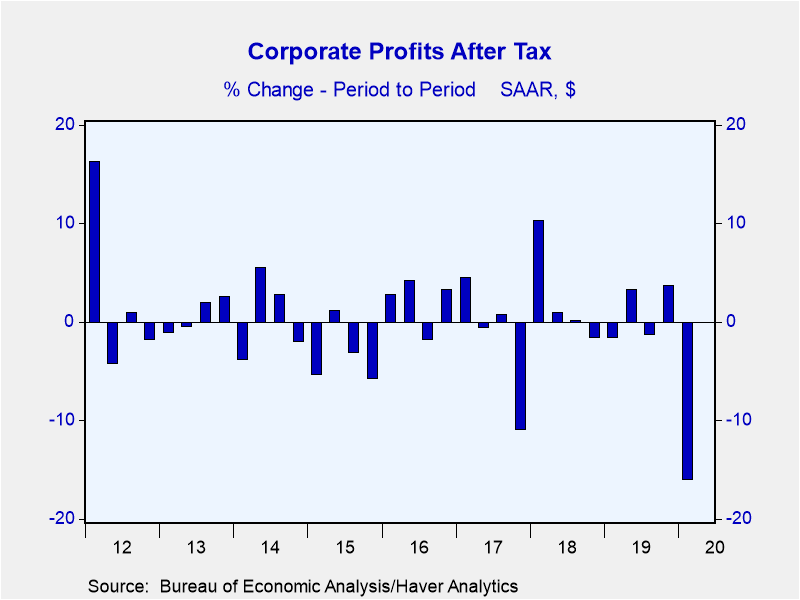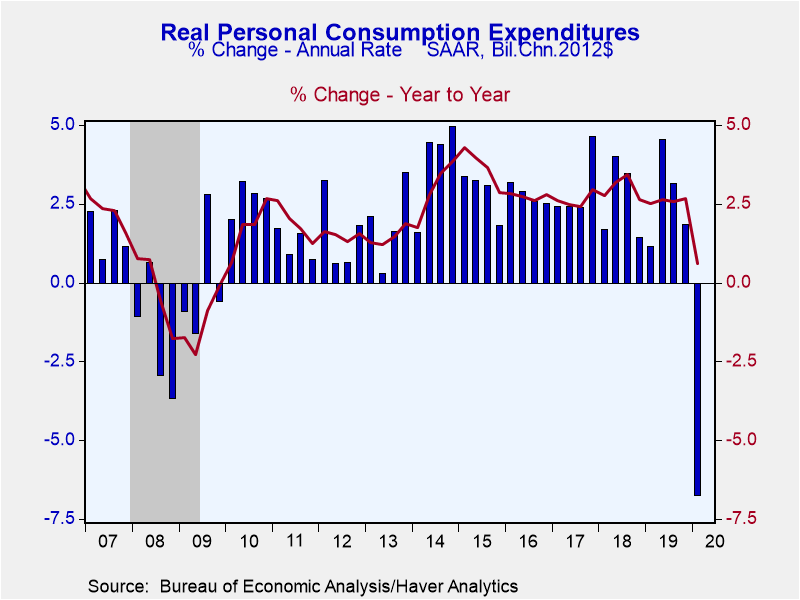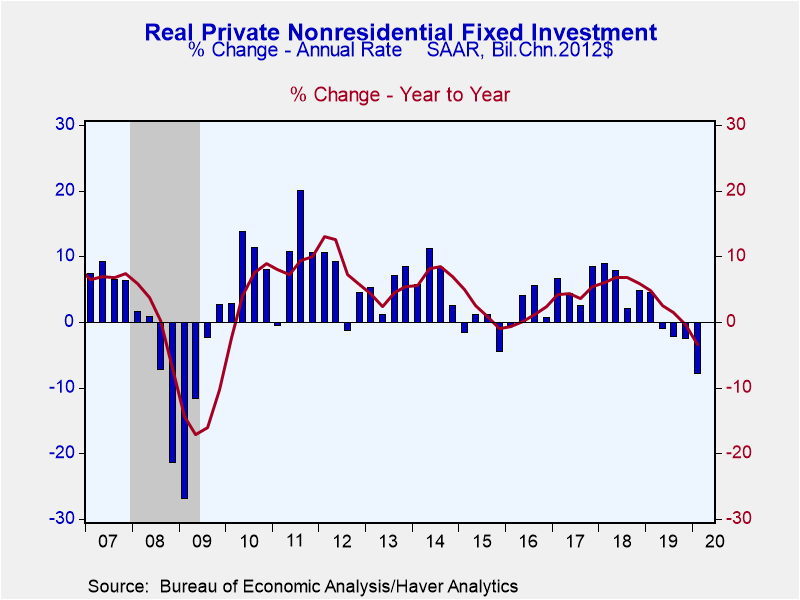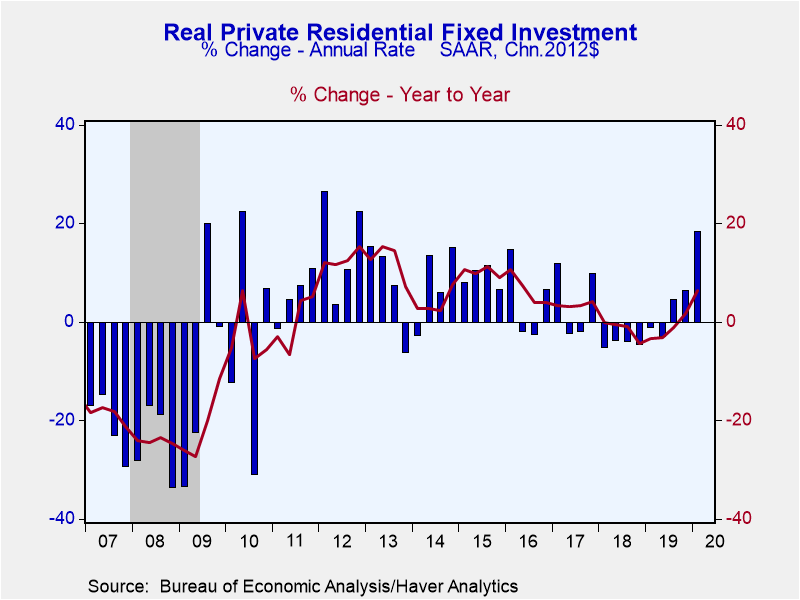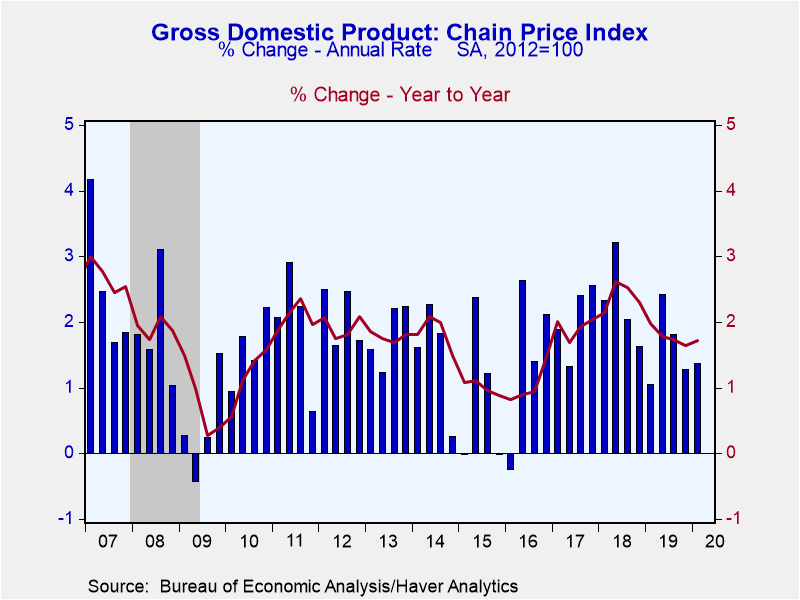 Global| May 28 2020
Global| May 28 2020U.S. GDP Decline in Q1'20 is Deepened; Corporate Profits Plunge
by:Tom Moeller
|in:Economy in Brief
Summary
• Revised GDP figures continue to show sharp falloff in activity. • Profits decline is greatest since 2008. • All sectors decline, except housing. • Price inflation remains under wraps. U.S. GDP declined 5.0% (SAAR) last quarter, [...]
• Revised GDP figures continue to show sharp falloff in activity.
• Profits decline is greatest since 2008.
• All sectors decline, except housing.
• Price inflation remains under wraps.
U.S. GDP declined 5.0% (SAAR) last quarter, revised from -4.8%, following a 2.1% Q4'19 rise. An unrevised 4.8% fall had been expected in the Action Economics Forecast Survey. The decline remained the first since Q1'14 and the largest since an 8.4% drop in Q4'08. A larger negative reading can be expected for Q2 as business shutdowns and dampened demand are measured for the whole quarter.
After-tax corporate profits without IVA & CCA declined 16.0% (-11.1% y/y) with the decline in business activity. Profits with IVA & CCA fell 13.9% (-8.5% y/y). Nonfinancial sector profits were off 11.9% (-5.2% y/y) while financial profits declined moderately. Foreign sector profits fell 10.8% (-3.2% y/y).
Domestic final sales was shaved to 4.8% last quarter from -5.4%. The decline was lessened as the consumer spending fell 6.8% (+0.6% y/y), revised from -7.6%. Durable goods outlays fell 13.2% (+2.2% y/y) as motor vehicle purchases weakened 29.1% (-2.9% y/y) and spending on home furnishings declined 4.3% (+2.8% y/y). Spending on recreational goods & vehicles rose 4.6% (10.1% y/y). Nondurable goods purchases increased 7.7% (4.3% y/y), revised from 6.9%. Food & beverage consumption surged 29.6% (9.2% y/y), revised from 25.1%. Clothing outlays declined 35.4% (-6.7% y/y) and spending on gasoline & oil fell 13.9% (-4.2% y/y), revised from -5.5%. Services outlays declined 9.7% (-0.7% y/y). Outlays on health care weakened 17.3% (-2.6% y/y), which was little changed and remained a quarterly record. Recreational spending declined by one-third (-7.0% y/y) as did restaurant and hotel outlays (-6.8% y/y). Financial services & insurance spending rose 3.4% (2.6% y/y).
Business fixed investment declined 7.9% (-3.4% y/y), revised from -8.6%. Structures outlays were off 3.9% (-8.1% y/y), revised from -9.7%. Equipment outlays fell 16.7% (-6.2% y/y), revised from -15.3%. Investment in information processing equipment declined 16.0% (-4.1% y/y) and industrial equipment spending fell 7.2% (-3.2% y/y). Transportation equipment outlays fell 31.5% (-14.0% y/y) but intellectual property products spending rose 1.0% (3.0% y/y).
An 18.5% increase (6.4% y/y) in residential investment was revised from 21.0% and remained the largest of three straight quarterly gains.
Government spending improved a little-changed 0.8%, still the weakest of five straight quarterly increases. Federal government outlays rose 1.8% (4.2% y/y) reflecting a weakened 1.0% rise (2.7% y/y) in defense outlays. Nondefense spending increased a lessened 3.1 % (-6.4% y/y). State & local government spending improved 0.2% (1.4% y/y) where growth has been declining since early last year.
Inventory liquidation subtracted 1.4 percentage points from GDP growth last quarter, revised from -0.5%. Improvement in the foreign trade balance added an unrevised 1.3 percentage points. Exports declined 8.7% (-2.9% y/y) and imports weakened 15.5% (-5.8% y/y).
The GDP price index rose an unrevised 1.3% (1.7% y/y). The PCE price index also gained 1.3% (1.6% y/y) and excluding food & energy, it rose 1.8% both q/q and y/y. The business fixed investment price index rose a steady 1.2% (1.0% y/y) and the residential investment price series improved 2.0% (2.4% y/y).
The GDP figures can be found in Haver's USECON and USNA database. USNA contains virtually all of the Bureau of Economic Analysis' detail in the national accounts. Both databases include tables of the newly published not seasonally adjusted data. The Action Economics consensus estimates can be found in AS1REPNA.
| Chained 2012 $ (%, AR) | Q1'20 (2nd Estimate) | Q1'20 (Advance Estimate) | Q4'19 | Q3'19 | Q1'20 Y/Y | 2019 | 2018 | 2017 |
|---|---|---|---|---|---|---|---|---|
| Gross Domestic Product | -5.0 | -4.8 | 2.1 | 2.1 | 0.3 | 2.3 | 2.9 | 2.4 |
| Inventory Effect (%-point) | -1.4 | -0.5 | -1.0 | 0.0 | 2.8 | 0.1 | 0.1 | 0.1 |
| Final Sales | -3.6 | -4.3 | 3.1 | 2.1 | 3.1 | 2.2 | 2.8 | 2.3 |
| Foreign Trade Effect (%-point) | 1.3 | 1.3 | 1.5 | -0.1 | 2.5 | -0.1 | -0.2 | -0.2 |
| Domestic Final Sales | -4.8 | -5.4 | 1.5 | 2.2 | 0.6 | 2.3 | 3.0 | 2.5 |
| Demand Components | ||||||||
| Personal Consumption Expenditure | -6.8 | -7.6 | 1.8 | 3.1 | 0.6 | 2.6 | 3.0 | 2.6 |
| Nonresidential Fixed Investment | -7.9 | -8.6 | -2.5 | -2.3 | -3.4 | 2.1 | 6.4 | 4.4 |
| Residential Investment | 18.5 | 21.0 | 6.5 | 4.6 | 6.4 | -1.5 | -1.5 | 3.5 |
| Government Spending | 0.8 | 0.7 | 2.5 | 1.7 | 2.5 | 2.3 | 1.7 | 0.7 |
| Chain-Type Price Index | ||||||||
| GDP | 1.3 | 1.3 | 1.3 | 1.8 | 1.7 | 1.8 | 2.4 | 1.9 |
| Personal Consumption Expenditure | 1.3 | 1.3 | 1.4 | 1.5 | 1.6 | 1.4 | 2.1 | 1.8 |
| Less Food & Energy | 1.8 | 1.8 | 1.3 | 2.1 | 1.8 | 1.6 | 1.9 | 1.6 |
| Nonresidential Investment | 1.2 | 1.2 | 0.4 | 0.5 | 1.0 | 1.2 | 1.4 | 1.0 |
| Residential Investment | 2.0 | 2.0 | 2.4 | 3.4 | 2.4 | 2.9 | 5.6 | 4.5 |
Tom Moeller
AuthorMore in Author Profile »Prior to joining Haver Analytics in 2000, Mr. Moeller worked as the Economist at Chancellor Capital Management from 1985 to 1999. There, he developed comprehensive economic forecasts and interpreted economic data for equity and fixed income portfolio managers. Also at Chancellor, Mr. Moeller worked as an equity analyst and was responsible for researching and rating companies in the economically sensitive automobile and housing industries for investment in Chancellor’s equity portfolio. Prior to joining Chancellor, Mr. Moeller was an Economist at Citibank from 1979 to 1984. He also analyzed pricing behavior in the metals industry for the Council on Wage and Price Stability in Washington, D.C. In 1999, Mr. Moeller received the award for most accurate forecast from the Forecasters' Club of New York. From 1990 to 1992 he was President of the New York Association for Business Economists. Mr. Moeller earned an M.B.A. in Finance from Fordham University, where he graduated in 1987. He holds a Bachelor of Arts in Economics from George Washington University.


